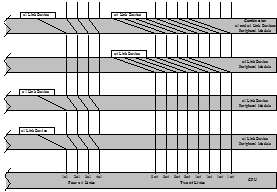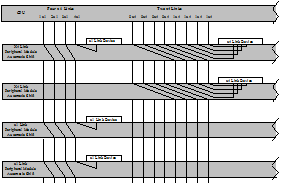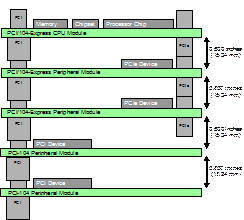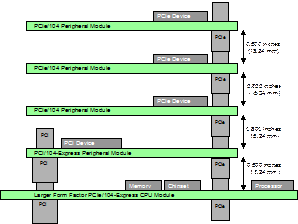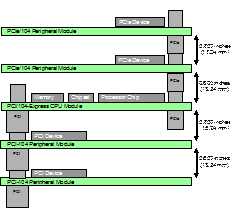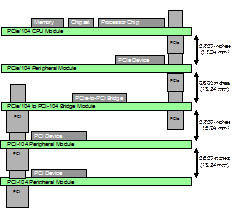What is PCI/104-Express™?
Introduction
The PCIe/104™ and PCI/104-Express™ specification establishes a standard to use high speed PCI Express® bus in stackable, modular embedded applications. It was developed by PC/104 Consortium members and adopted by its voting members in March 2008. The PC/104 Consortium chose PCI Express because of its full PC market adoption, performance, scalability, and growing silicon availability worldwide. It provides a high-performance physical interface while retaining software compatibility with existing PCI™ infrastructure.
EPIC-Express™ and EBX-Express™ are the embodiments of PCIe/104 on the PC/104 Consortium’s EPIC and EBX form factors.
Incorporating the PCI Express bus within the industry proven PC/104™ architecture brings many advantages for embedded applications including fast data transfer, low cost due to PC/104’s unique self-stacking bus, high reliability due to PC/104’s inherent ruggedness, and long term sustainability.
Background
The main objective in defining an addition of PCI Express to PC/104™ architecture was to preserve the attributes that have made PC/104 so successful in embedded applications, namely:
- Compact: 3.6 by 3.8 inches (90 x 96 mm) module size
- Self-stacking: expands without backplanes or card cages
- Rugged, reliable connectors: reliable in harsh environments
- Four-corner mounting holes: resistance to shock and vibration
- Fully PC compatible: reduced development costs and time-to-market
In addition, it was important that a stackable form of PCI Express take into consideration backward compatibility with current PC/104 Consortium specifications and form factors. The design had to support automatic detection of up or down stacking and had to have automatic link shifting to allow simplified, universal add-on module designs.
The PCI/104-Express design approach provides a consistent and interchangeable path for the stackable PC architecture across the PC/104 Consortium’s original 104™ size and the larger EPIC™ and EBX™ form factors.
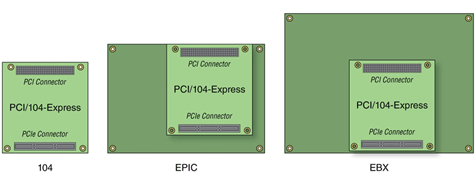
PC/104 Architecture Form Factors shown with PCI/104-Express Connectors
PCI/104-Express & PCIe/104 Specification Overview
There are two versions of PCIe/104 that are complementary. The main difference is that Type 2 replaces the PCI Express x16 link with SATA, USB 3.0, LPC, and RTC battery.
Both PCIe/104 Type 1 and Type 2 have this common feature set and pin assignments:
- Four x1 PCI Express Links
- Two USB 2.0
- ATX power and control signals: +5V Standby, Power supply on, Power OK
- Power: +3.3V, +5V, +12V
- SMBus
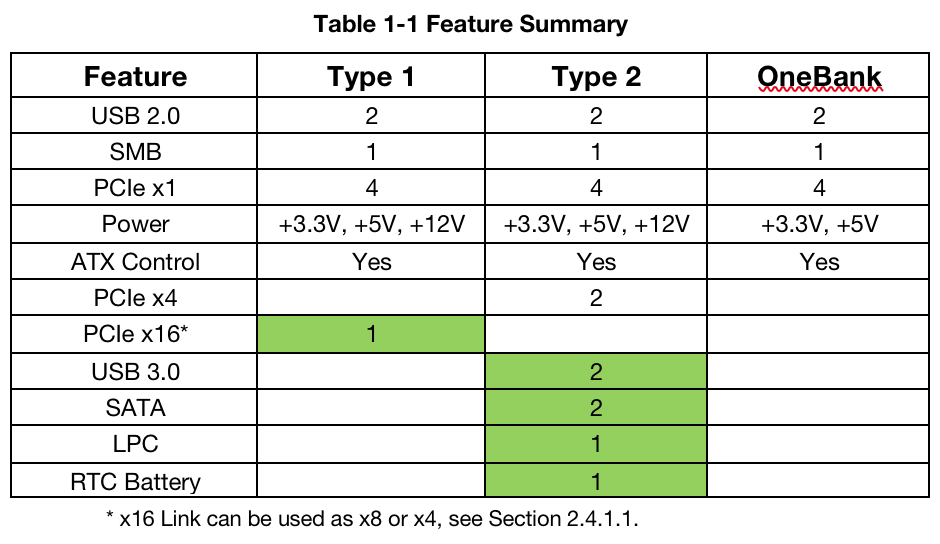 Type 1 has the common feature set plus:
Type 1 has the common feature set plus:
- One x16 PCI Express Link that can be configured as two x8 Links or two x4 PCI Express Links dependent on the host.
Type 2 has the common feature set plus:
- Two x4 PCI Express Links
- Two USB 3.0
- Two SATA
- LPC Bus
- RTC Battery
Type 1 and Type 2 stacking rules explained:
- PCI Express x1, PCI Express x4, or USB 2.0 peripheral cards are universal and can plug into either Type 1 or Type 2 hosts.
- PCI Express x16 peripheral cards must plug into Type 1 hosts.
- SATA, USB 3.0, and LPC peripheral cards must plug into Type 2 hosts.
- Anything plugged in the wrong bus holds the system in reset and causes no damage.
PCI-104 PCI Bus connector
- PCI Bus: 32-bit, 33 MHz, Four Bus Master capable (same as on PC/104-Plus and & PCI-104)
- Power: +3.3V, +5V, +12V, -12V, +5V Standby, Power Supply On, and PME for ATX power supply
PCI/104-Express Connector
The PCI Express connector was specifically designed for the PC/104 Consortium to match the PC/104 standard 0.600 inch (15.24mm) stacking height and standoff tolerances. It was then tested to ensure it meets the PC/104 durability expectations and PCI Express signal integrity requirements. A 0.866 inch (22.00mm) version is also specified.

0.600” (15.24mm) Top Connector

Bottom Connector

0.866” (22.00mm) Top Connector
Connector Signal Integrity
Signal integrity testing sponsored by consortium members ensures PCI Express reliability in PC/104 architecture.
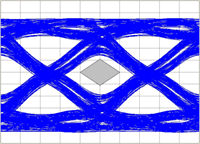 |
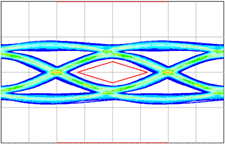 |
| PCIe® Generation 1 | PCIe® Generation 2 |
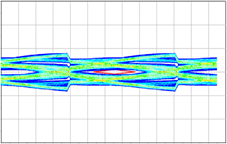 |
|
| PCIe® Generation 3 | |
Link Shifting Stack Examples
Link shifting allows universal add-in card design and automatic PCI Express link assignment.
Up or Down Stack Configuration Examples
The flexibility and expandability of the bus and mechanical layout allow many different stack configurations to support an array of diverse project requirements. See full specification for more examples.
PC/104 Bus Evolution
PC/104 stackable embedded PCs have followed the desktop PC leveraging on the hardware and software support developed for this popular platform.
What is the difference between PCIe/104 and PCI/104-Express?
PCIe/104 is PCI/104-Express without the PCI bus. A comparison between a PCI/104-Express Stack and a PCIe/104 stack shows that both easily support PCI Express and PCI add-in cards with the addition of a simple PCI Express-to-PCI bridge in the PCIe/104 stack.
Current Status of the PCI/104-Express Standard
The initial specification was adopted by PC/104 Consortium in March 2008 and revision 2.1 was approved by member vote in February 2013. This revision introduces the rules for using PCI Express Generation 2 and Generation 3 with PCIe/104.
Copies of the PCIe/104 Specification are available to individuals and companies developing embedded systems.
Other PC/104 Specifications
The PC/104 Consortium maintains the PC/104™, PC/104-Plus™, and PCI-104™ specifications on the 104™ form factor as well as the specifications for the EPIC™ and EBX™ form factors.
PC/104 is the original specification. It defined the 104 form factor at 3.550 x 3.775 inch (90.17 x 95.89 mm) with a stacking ISA bus. There are 8-bit (XT) and 16-bit (AT) versions.
PC/104-Plus added PCI bus to classic PC/104 on the 104 form factor. 132M Bytes per second transfer rate made high speed processing possible in rugged embedded systems while the ISA bus allowed use of the extensive infrastructure of embedded modules.
PCI-104 actually existed in the PC/104-Plus specification, but it didn’t have a name. Instead of calling it “PC/104-Plus PCI only” forever, the consortium decided to give it its own specification and PCI-104 was born with only a PCI bus on the 104 form factor.
EPIC and EPIC Express (Embedded Platform for Industrial Computing) was the first to be introduced. At 4.528 x 6.496 inches (115.00 x 165.00 mm), it is larger than the 104 form factor and allows room for tall cooling solutions for high end processors with space for standard PC style I/O connectors.
EBX and EBX Express (Embedded Board, eXpandable) is the original 5¼ inch form factor of many single board computers. At 5.750 x 8.000 inches (146.05 x 203.20 mm) it has room for a complete computer with standard I/O and memory DIMMs but still features PC/104-Plus or PCI/104-Express expansion for flexibility and expandability.
Where Do PCI/104-Express and PCIe/104 Fit?
The PCI/104-Express & PCIe/104 specifications continue to following the desktop PC and the path provided by the major processor and chipset manufacturers.
- PC/104 supports ISA only
- PC/104-Plus supports PCI and ISA
- PCI-104 supports PCI only
And now
- PCI/104-Express supports PCI Express and PCI
- PCIe/104 supports PCI Express only
Trademarks
The PC/104 logo, PC/104, PC/104-Plus, PCI-104, PCI/104-Express, PCIe/104, 104, EPIC, EPIC Express, EBX, and EBX Express are trademarks of the PC/104 Consortium. PCI, PCI Express, and PCIe are trademarks of PCI-SIG.
Download Specification